
The purpose of this activity/lesson is to identify the type and availability of employment opportunities inyour community.
- Subject:
- Mathematics
- Material Type:
- Lesson Plan
- Author:
- Larissa Mallon
- Date Added:
- 01/07/2020

The purpose of this activity/lesson is to identify the type and availability of employment opportunities inyour community.
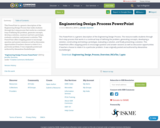
This PowerPoint is a generic description of the Engineering Design Process that walks students through the 6 step process that works in a continual loop of defining the problem, generate concepts, develop a solution, construct and test a prototype, evaluate a solution, and present a solution. This PowerPoint offers stopping points to encourage question and answer sessions as well as discussion opportunities if teachers choose to relate it to a particular problem. It was originally posted and authored by Alexandrea Dunkelberger.
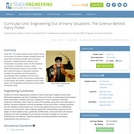
Under the "The Science Behind Harry Potter" theme, a succession of diverse complex scientific topics are presented to students through direct immersive interaction. Student interest is piqued by the incorporation of popular culture into the classroom via a series of interactive, hands-on Harry Potter/movie-themed lessons and activities. They learn about the basics of acid/base chemistry (invisible ink), genetics and trait prediction (parseltongue trait in families), and force and projectile motion (motion of the thrown remembrall). In each lesson and activity, students are also made aware of the engineering connections to these fields of scientific study.

Are you ready to BUILD? Get ready to launch an engaging community-building Challenge."More than 90% of the students and teachers who have completed our challenge said they would recommend it to others."Watch your students embrace entrepreneurial thinking as they create real-world solutions to today’s challenges. BUILD's Thriving Communities Design Challenge invites youth to use Design Thinking to answer: How might we build powerful, thriving communities where everyone enjoys safety, wellness, and economic freedom.

This project outlines the procedures for creating and integrating environmental sensors into a study site.
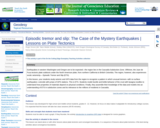
Earthquakes in western Washington and Oregon are to be expected -- the region lies in the Cascadia Subduction Zone. Offshore, the Juan de Fuca tectonic plate subducts under the North American plate, from northern California to British Columbia. The region, however, also experiences exotic seismicity -- Episodic Tremor and Slip (ETS).In this lesson, your students study seismic and GPS data from the region to recognize a pattern in which unusual tremors--with no surface earthquakes--coincide with jumps of GPS stations. This is ETS. Students model ductile and brittle behavior of the crust with lasagna noodles to understand how properties of materials depend on physical conditions. Finally, they assemble their knowledge of the data and models into an understanding of ETS in subduction zones and its relevance to the millions of residents in Cascadia.
(Note: this resource was added to OER Commons as part of a batch upload of over 2,200 records. If you notice an issue with the quality of the metadata, please let us know by using the 'report' button and we will flag it for consideration.)
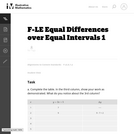
An important property of linear functions is that they grow by equal differences over equal intervals. In this task students prove this for equal intervals of length one unit, and note that in this case the equal differences have the same value as the slope. In F.LE Equal Differences over Equal Intervals 2, students prove the property in general (for equal intervals of any length).
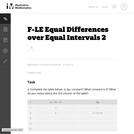
An important property of linear functions is that they grow by equal differences over equal intervals. In this task students prove this for equal intervals of length one unit, and note that in this case the equal differences have the same value as the slope.
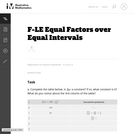
In this task students prove that linear functions grow by equal differences over equal intervals, and that exponential functions grow by equal factors over equal intervals.

Explore what it means for a mathematical statement to be balanced or unbalanced by interacting with objects on a balance. Discover the rules for keeping it balanced. Collect stars by playing the game!

This is an example of EquatIO math inserted into OER commons
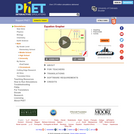
Learn about graphing polynomials. The shape of the curve changes as the constants are adjusted. View the curves for the individual terms (e.g. y=bx ) to see how they add to generate the polynomial curve.

Learn about graphing polynomials. The shape of the curve changes as the constants are adjusted. View the curves for the individual terms (e.g. y=bx ) to see how they add to generate the polynomial curve.
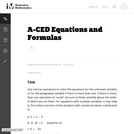
This task asks students to use inverse operations to solve the equations for the unknown variable, or for the designated variable if there is more than one. Two of the equations are of physical significance and are examples of Ohm's Law and Newton's Law of Universal Gravitation.
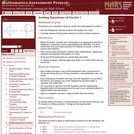
This lesson unit is intended to help teachers assess how well students are able to: use the Pythagorean theorem to derive the equation of a circle; and translate between the geometric features of circles and their equations.
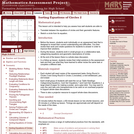
This lesson unit is intended to help teachers assess how well students are able to: translate between the equations of circles and their geometric features; and sketch a circle from its equation.
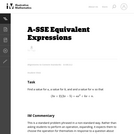
This is a standard problem phrased in a non-standard way. Rather than asking students to perform an operation, expanding, it expects them to choose the operation for themselves in response to a question about structure. The problem aligns with A-SSE.2 because it requires students to see the factored form as a product of sums, to which the distributive law can be applied.
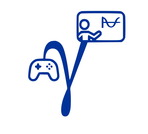
This is a collection of the results of the Erasmus+ project GAMMA: GAMe-based learning in MAthematics. In the GAMMA project, we have developed education materials for mathematics teachers who want to integrate GBL founded on digital technology effectively into their teaching practice. The materials could also be useful for teachers of other subjects who wish to integrate this method into their teaching. The authors are team members from GAMMA partner institutions.
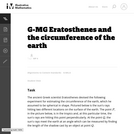
The accuracy and simplicity of this experiment are amazing. A wonderful project for students, which would necessarily involve team work with a different school and most likely a school in a different state or region of the country, would be to try to repeat Eratosthenes' experiment.

Students learn that buoyancy is responsible for making boats, hot air balloons and weather balloons float. They calculate whether or not a boat or balloon will float, and calculate the volume needed to make a balloon or boat of a certain mass float. Conduct the first day of the associated activity before conducting this lesson.